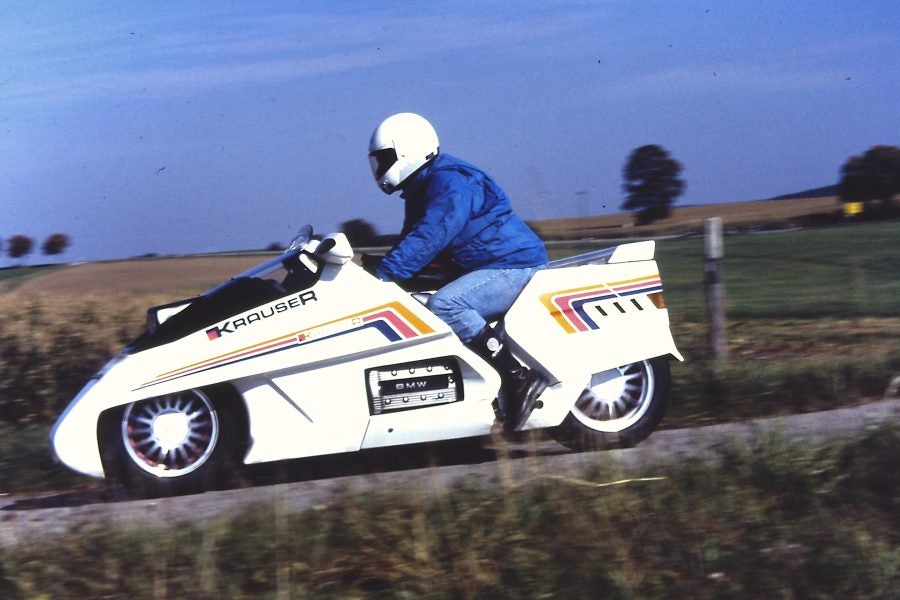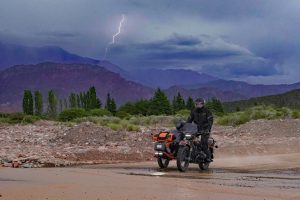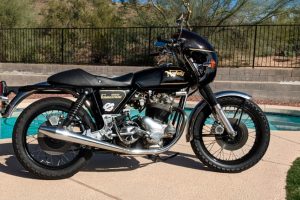我用一种困惑的难以置信的看着我riend Michel’s R100 S hit a pothole and lost its right-hand pannier. This fell off onto the road, then did a couple of lazy flips before disappearing over the side of the steep embankment we were crossing, somewhere on the Anatolian plateau. Down below in a stubble field, a local whom I took to be the farmer watched with every bit as much bemusement as I felt. Surely he couldn’t have been familiar with Krauser panniers?

The guilty Krauser panniers. Fortunately, they were strong enough to survive “involuntary detachment”. (Photo Krauser)
Take a look at a photo of an Australian BMW tourer from the late ‘60s or the ‘70s, and chances are that you will notice that the panniers, whether they are badged ‘BMW’ or ‘Krauser’, have straps around them. The panniers were all made by Krauser and either supplied to BMW or sold direct, and they all had a habit of falling off. Whenever they hit a pothole, riders would feel behind them to make sure the panniers were still there until they, too, learned to collect a pair of BMW packing straps from their dealer.
Not that Mike, or ‘Gigi’ Krauser as he was also known, ever knowingly created any dud products. I suspect that the reason for the notorious ‘involuntary detachment’ of the panniers was that Mike designed for the smoothness of German roads, not the rough roads of places like Australia – or Turkey. He might have had smooth racetracks in mind, too. He had a lot to do with racing, first as a highly successful racer himself on sand and tar with two wheels and three, and later as an outstanding sponsor and team chief.

Krauser’s MKM1000 was a very expensive but also very good motorcycle. (Photo BIKE Australia)
One of his outrageous creations was the MKM1000, based on a BMW R100 but with four-valve heads of Mike’s design and a lavender-colored space frame.
Mike Krauser died in 1991, and to me he will always be one of the trio of independent German motorcycle industry figures who did so much to make motorcycling a fascinating pastime for my generation. The others were Friedl Münch and Fritz Egli (oh all right, Fritz is Swiss, but he speaks German) and it has been my pleasure and privilege to meet them all.

Mike Krauser, second from left, with one of the race bikes he sponsored. (Photo Krauser)
One year I sought out the Krauser stand at IFMA, which is what INTERMOT was called when it was in Munich, because I had visited the factory a couple of years earlier.
“We owe you lunch,” said Young Mrs. Krauser (Mike’s wife was plain Mrs. Krauser) after greeting me on the stand. “You helped us to get the biggest order for Domanis we have ever had.”

The look of the Domani was well ahead of its time. (Photo The Bear)
On that visit, from memory in 1992, I had sort-of tested (really just hooned around on, having a great time) the Krauser Domani, easily the best factory motorcycle outfit ever made. The Domani was not a motorcycle with a sidecar attached to it; the design was a fully integrated vehicle, something that has since become rather more common with some spectacular creations – especially out of France. But the Domani was the first, and is probably still the best-looking. A timeless, superbly proportioned flying wedge that drew eyes wherever it went.
Oddly, Domanis were not the fireballs they looked like. I sold an article about my ride to the Australian magazine ‘Motor’, and the editor was surprised when he read in my story that the top speed was “only”, as he put it, 200 km/h. It is true that the Domani looks faster than that just standing still, but since it was powered by a more or less standard four-cylinder K100 BMW engine, it was only its amazingly low weight of 390 kg that enable it to even reach that speed.

A look at the insides of the Domani, showing the hub-centre steering. (Image Krauser)
Young Mrs. Krauser told me that they had had an order for a dozen Domanis from New Zealand, and that the order had mentioned my story in ‘Motor’. Keep in mind that New Zealand would have had a population of about two million then, and they all (mostly) drove on the left, whereas Domanis are set up to be driven on the right and can’t be changed over. Apparently the Krauser workshop had been unable to fill the complete order, but they had shipped eight of the outfits to the antipodes. I cheerfully accepted the lunch invitation, but I thought there was definitely something odd about that story.

The Domani stripped down and on show at IFMA. (Photo The Bear)
Barry Lake, then editor of ‘Motor’, confirmed my misgivings. “Ha!” he said, “they would not even have touched the wharf in New Zealand. They would have gone straight to Japan, and they’re now sitting in showrooms to demonstrate how cool the companies are!” I did a little checking and found that he was right. Apparently Krauser had refused to sell more of them to Japan because they knew of their potential fates as showpieces. They wanted them to be ridden, instead.
My story had provided the ideal opportunity for the Japanese to do a quick switcheroo on the Germans. I never did tell Young Mrs. Krauser.







